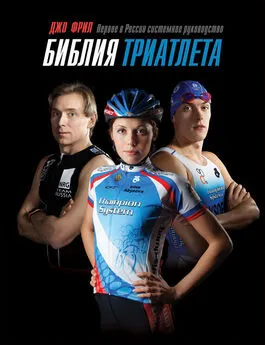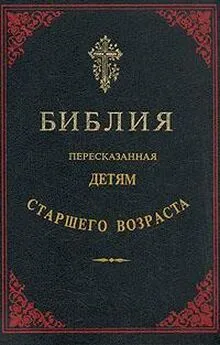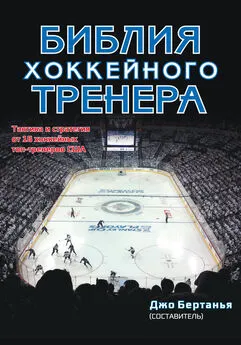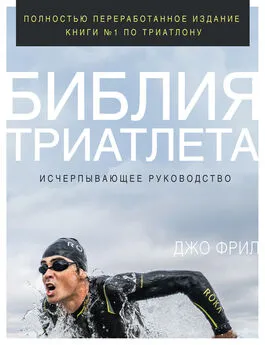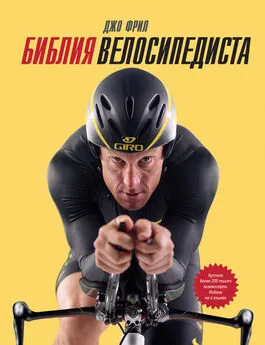Джо Фрил - Библия триатлета
- Название:Библия триатлета
- Автор:
- Жанр:
- Издательство:Манн, Иванов и Фербер
- Год:2011
- Город:Москва
- ISBN:978-5-91657-184-4
- Рейтинг:
- Избранное:Добавить в избранное
-
Отзывы:
-
Ваша оценка:
Джо Фрил - Библия триатлета краткое содержание
Эта книга поможет вам подготовиться к соревнованиям: спринт-триатлону, олимпийской дистанции, Half-Ironman и, наконец, полному Ironman. В ней учтены особенности тренировки самых разных групп спортсменов: по полу, возрасту, уровню начальной подготовки. Четкая структура, понятные описания, иллюстрации и удобные таблицы контрольных данных позволят вам разработать собственную систему тренировок, а затем планомерно идти к вашей высокой цели.
Эта книга совершенно необходима всем, кто уже занимается триатлоном или только собирается им заняться.
Библия триатлета - читать онлайн бесплатно ознакомительный отрывок
Интервал:
Закладка:
A2. Брик-интервалы по бегу.Принесите к месту занятия свой велотренажер. Для разминки пробегитесь в течение 10–20 минут в зонах 1–3. Затем занимайтесь на велотренажере в течение 5–10 минут, в последнюю минуту достигая зон 4–5a. Переобуйтесь для бега и проделайте 2–4 интервала по 2–4 минуты, повышая интенсивность при каждом интервале до зоны 5b. Продолжительность восстановительных интервалов должна составлять половину продолжительности предыдущего рабочего интервала. Вернитесь к тренажеру и катайтесь примерно 5 минут, наращивая интенсивность до зон 4–5a. Повторите это упражнение от одного до трех раз, затем перейдите к 10-минутной заминке на велосипеде. Общее время рабочих интервалов для бега должно составлять примерно 20 минут (или расстояние в 5 км). (Периоды: Строительство 2, Пиковый.)
Приложение F
Форма оценки гонки, ведение дневника
Форма оценки гонки
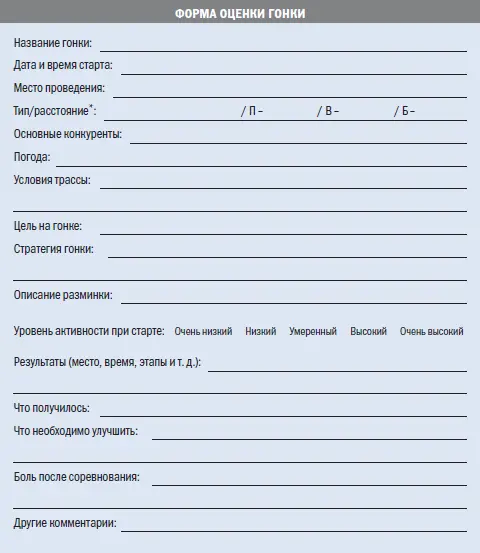
* П – плавание, В – велосипед, Б – бег. Аббревиатуры используются для экономии времени записи. Прим. ред.
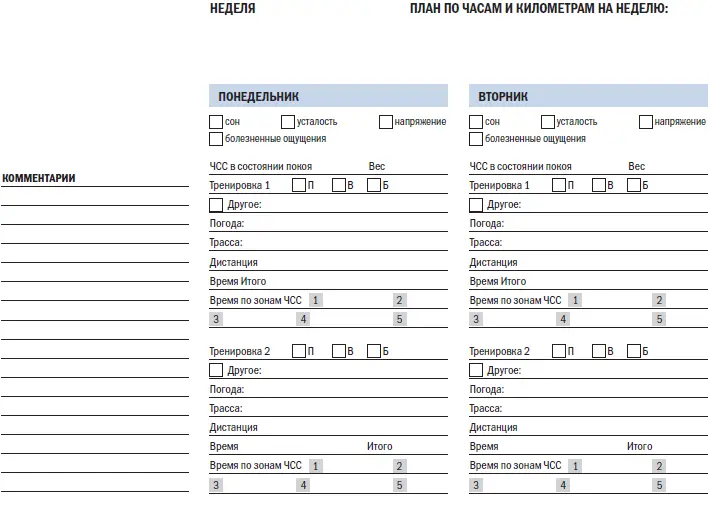
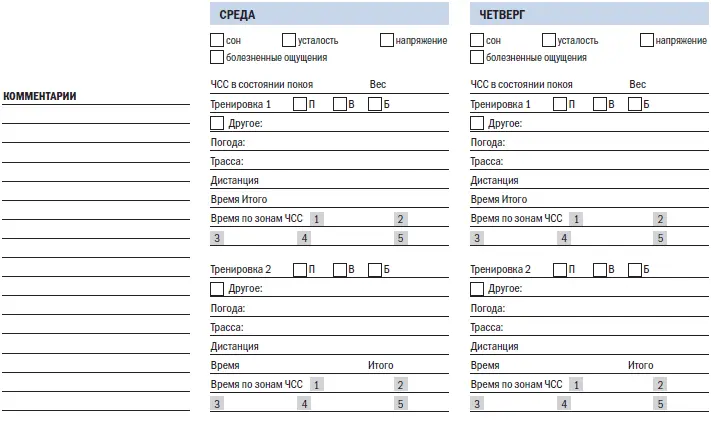

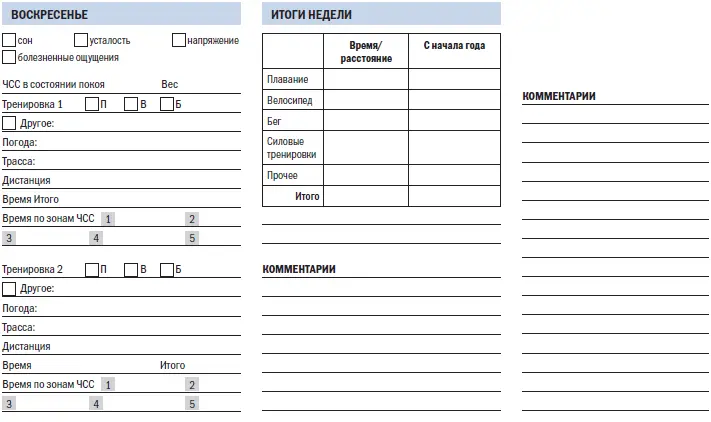
Использованная и рекомендуемая литература
Alter, M. J. Sport Stretch . Champaign, IL: Human Kinetics, 1998.
American College of Sports Medicine. Antioxidants and the Elite Athlete: Материалы дискуссии, 27.05.1992, Dallas, TX.
American Dietetic Association. Nutrition and Physical Fitness and Athletic Performance // Journal of the American Dietetics Association 87 (1987): 933–939.
Anderson, B. Stretching . Bolinas, CA: Shelter Publications, 1980.
Anderson, O. Carbs, Creatine & Phosphate: If the King Had Used These Uppers, He’d Still Be Around Today // Running Research News 12, no. 3 (1996): 1–4.
Anderson, O. German Study Confirms Major Shifts in Intensity Work Far Better Than Big Upswings in Mileage // Running Research News 12, no. 9 (1996): 1–5.
Anderson, O. The Search for the Perfect Intensity Distribution // Cycling Research News 1, no. 10 (2004): 1, 4–10.
Anderson, O. Things Your Parents Forgot to Tell You about Tapering // Running Research News 11, no. 7 (1995): 1–8.
Appell, H. J. et al. Supplementation of Vitamin E May Attenuate Skeletal Muscle Immobilization Atrophy // International Journal of Sports Medicine 18 (1997): 157–160.
Armsey, T. D., and Green, G. A. Nutrition Supplementation: Science vs. Hype // T he Physician and Sports Medicine 25, no. 6 (1997): 77–92.
Astrand, P. O., and Rohdahl, K. Textbook of Work Physiology . New York: McGraw-Hill, 1977.
Atwater, A. E. Gender Differences in Distance Running // Biomechanics of Distance Running / ed. P. R. Cavanagh. Champaign, IL: Human Kinetics, 1990.
Balaban, E. P. et al. The Frequency of Anemia and Iron Deficiency in the Runner // Medicine and Science in Sport and Exercise 21 (1989): 643–648.
Balsam, P. D. Creatine Supplementation Per Se Does Not Enhance Endurance Exercise Performance // Acta Physiologica Scandinavica 149, no. 4 (1993): 521–523.
Bemben, D. A. et al. Effects of Oral Contraceptives on Hormonal and Metabolic Responses during Exercise // Medicine and Science in Sport and Exercise 24, no. 4 (1992): 434–441.
Bernhardt, G. Training Plans for Multisport Athletes . Boulder, CO: VeloPress, 2000.
Billat, V. L. et al. Physical and Training Characteristics of Top-Class Marathon Runners // Medicine and Science in Sports and Exercise 33, no. 12 (2001): 2089–2097.
Blomstrand, E. et al. Administration of Branched Chain Amino Acids during Sustained Exercise – Effects on Performance and on Plasma Concentrations of Some Amino Acids // European Journal of Applied Physiology 63, no. 2 (1991): 83–88.
Bompa, T. From Childhood to Champion Athlete . Toronto, ON: Veritas Publishing, 1995.
Bompa, T. Periodization of Strength . Toronto, ON: Veritas Publishing, 1993.
Bompa, T. Physiological Intensity Values Employed to Plan Endurance Training // New Studies in Athletics 3, no. 4 (1988): 37–52.
Bompa, T. Theory and Methodology of Training . Dubuque, IA: Kendall/Hunt Publishing, 1994.
Bonen, A., and Belcastro, A. Comparison of Self-Selected Recovery Methods on Lactic Acid Removal Rates // Medicine and Science in Sports and Exercise 8 (1976): 176–178.
Borg, G. An Introduction to Borg’s RPE-Scale . Ithaca, NY: Movement Publications, 1985.
Bouchard, C., and Lortie, G. Heredity and Endurance Performance // Sports Medicine 1 (1984): 38–94.
Brenner, I. K. M. Infection in Athletes // Sports Medicine 17, no. 2 (1994): 86–107.
Broker, J. P., and Gregor, R. J. Cycling Biomechanics // High-Tech Cycling / ed. E. Burke. Champaign, IL: Human Kinetics, 1996.
Brown, C., and Wilmore, J. The Effects of Maximal Resistance Training on the Strength and Body Composition of Women Athletes // Medicine and Science in Sports and Exercise 6 (1974): 174–177.
Brunner, R., and Tabachnik, B. Soviet Training and Recovery Methods . Pleasant Hill, CA: Sport Focus Publishing, 1990.
Brzycki, M. Strength Testing – Predicting a One-Rep Max from Reps to Fatigue // Journal of Physical Education, Recreation and Dance 64 (1993): 88–90.
Budgett, R. Overtraining Syndrome // British Journal of Sports Medicine 24 (1990): 231–236.
Bull, S. J. Sports Psychology: A Self-Help Guide . Marlborough, UK: Crowood Press, 2000.
Bunt, J. C. et al. Sex and Training Differences in Human Growth Hormone Levels during Prolonged Exercise // Journal of Applied Physiology 61 (1986): 1796.
Burke, E. High-Tech Cycling . Champaign, IL: Human Kinetics, 1996.
Burke, E. Serious Cycling . Champaign, IL: Human Kinetics, 1995.
Burke, L. M., and Read, R. S. D. Dietary Supplements in Sport // Sports Medicine 15 (1993): 43–65.
Butts, N. K., Henry, B. A., and Mclean, D. Correlations between V02Max and Performance Times of Recreational Triathletes // Journal of Sports Medicine and Physical Fitness 31, no. 3 (1991): 339–344.
Cade, J. R. et al. Dietary Intervention and Training in Swimmers // European Journal of Applied Physiology 63 (1991): 210–215.
Cavanagh, P. R., and Sanderson, D. J. The Biomechanics of Cycling: Studies of the Pedaling Mechanics of Elite Pursuit Riders // Science of Cycling / ed. E. Burke. Champaign, IL: Human Kinetics, 1986.
Cavanagh, P. R. et al. A Biomechanical Comparison of Elite and Good Distance Runners // Annals of the New York Academy of Sciences 301 (1977): 328–345.
Cerra, F. B. et al. Branched-Chain Amino Acid Supplementation during Trekking at High Altitude // European Journal of Applied Physiology 65 (1984): 394–398.
Child, J. S. et al. Cardiac Hypertrophy and Function in Masters Endurance Runners and Sprinters // Journal of Applied Physiology 57 (1984): 170–181.
Clark. Red Meat: To Eat or Not to Eat // National Strength and Conditioning Association Journal 15 (1993): 71–72.
Clement, D. B. et al. Branched-Chain Metabolic Support: A Prospective, Randomized Double-Blind Trial in Surgical Stress // Annals of Surgery 199, no. 3 (1984): 286–291.
Cohen, J., and Gisolfi, C. V. Effects of Interval Training in Work-Heat Tolerance in Young Women // Medicine and Science in Sport and Exercise 14 (1982): 46–52.
Conley, D. L., and Krahenbuhl, G. Running Economy and Distance Running Performance of Highly Trained Athletes // Medicine and Science in Sports and Exercise 12, no. 5 (1980): 357–360.
Conley, D. L. et al. Following Steve Scott: Physiological Changes Accompanying Training // The Physician and Sports Medicine 12, no. 1 (1984): 103–106.
Cordain, L. Department of Exercise and Sport Science . Colorado State University, Fort Collins, CO (1998). Личное общение с автором.
Cordain, L. The Paleo Diet . New York: Wiley, 2002.
Cordain, L., and Friel, J. The Paleo Diet for Athletes . Emmaus, PA: Rodale, 2005.
Cordain, L., Gotshall, R. W., and Eaton, S. B. Evolutionary Aspects of Exercise // World Review of Nutrition and Dietetics 81 (1997): 49–60.
Costill, D. Predicting Athletic Potential: The Value of Laboratory Testing // Sports Medicine Digest 11, no. 11 (1989): 7.
Costill, D. et al. Adaptations to Swimming Training: Influence of Training Volume // Medicine and Science in Sports and Exercise 23 (1991): 371–377.
Costill, D. L. et al. Effects of Repeated Days of Intensified Training on Muscle Glycogen and Swimming Performance» // Medicine and Science in Sport and Exercise 20 (1988): 249–254.
Coyle, E. F. et al. Cycling Efficiency Is Related to the Percentage of Type I Muscle Fibers // Medicine and Science in Sports and Exercise 24 (1992): 782.
Cunningham, D. A. et al. Cardiovascular Response to Intervals and Continuous Training in Women // European Journal of Applied Physiology 41 (1979): 187–197.
Daniels, J. Daniels’ Running Formula. 2nd edition. Champaign, Human Cinetics, 2005.
Daniels, J. Physiological Characteristics of Champion Male Athletes // Research Quarterly 45 (1989): 342–348.
Daniels, J. et al. Interval Training and Performance // Sports Medicine 1 (1984): 327–334.
David, A. S. et al. Post-Viral Fatigue Syndrome: Time for a New Approach // British Medical Journal 296 (1988): 696–699.
Davis, J. M. Carbohydrates, Branched-Chain Amino Acids, and Performance – the Central Fatigue Hypothesis // International Journal of Sport Nutrition 5 (1995): S29-S38.
Deuster, P. A. et al. Nutritional Survey of Highly Trained Women Runners // American Journal of Clinical Nutrition 45 (1986): 954–962.
Читать дальшеИнтервал:
Закладка:
